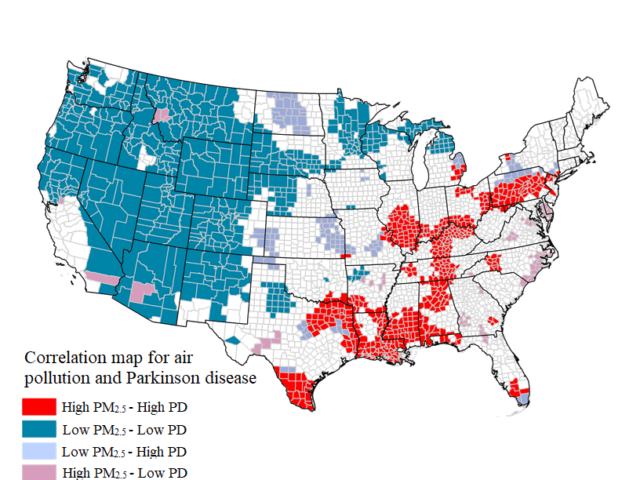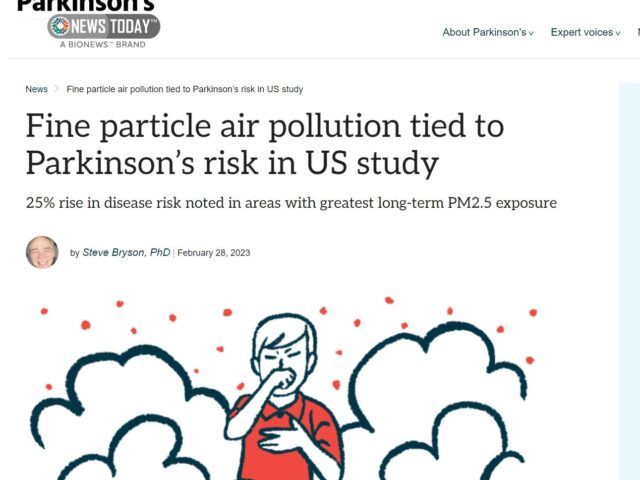Environmental Risk Factors and Parkinson’s Disease
In collaboration with Dr. Rodolfo Savica of Mayo Clinic Rochester, we used population-based data to provide compelling evidence that fine particulate matter (PM2.5) is associated with increased risk of Parkinson’s disease (PD), dyskinesia, and specifically the akinetic-rigid phenotype of PD. Our laboratory has helped to identify an association between incident PD and exposure to air pollution in the form of fine particulate matter (PM2.5). We also identified a Parkinson’s disease hotspot in the Mississippi-Ohio River Valley region of the U.S. This work provides evidence of PM2.5 as a modifiable environmental risk factor associated with Parkinson’s disease and further offers specific regions to focus efforts for environmental remediation.
Expanding on this work, we led efforts to investigate the association between exposure to airborne trichloroethylene (TCE) and PD. This work offers insight into airborne TCE as a PD risk factor for metropolitan populations.
We also led recent work that identified the Great Plains and Rocky Mountain regions as the part of the nation with the strongest association between PD and cropland density (a proxy for pesticide exposure). Specifically, we found the strongest association in the Williston Basin of the Great Plains, where there was a 2-fold greater risk of PD for those living with the highest levels of cropland density compared to the lowest. From this work, I additionally identified lindane, permethrin, and paraquat as possible pesticides of interest for further investigation in that region. This work offers insight into region-specific associations and directions for future research.
Related Publications
- Krzyzanowski B., Mullan, A.F., Turcano, P., Camerucci, E., Bower, J.H., and Savica, R. (2024). Air pollution and Parkinson Disease in a population-based study of clinical characteristics. JAMA Open Network.
- Krzyzanowski, B., Searles Nielsen, S., Turner, J.R., and Racette, B.A. (2023). Fine particulate matterand Parkinson Disease Risk in Medicare Beneficiaries. Neurology, 101(21), e2058-e2067.
- Krzyzanowski, B., Searles Nielsen, S., and Racette, B.A. (2024). Airborne Trichlorethylene Exposure and Parkinson Disease Risk in Medicare Beneficiaries. Presented at AAN in Denver, CO.
- Killion, J., Krzyzanowski, B., Searles Nielsen, S., and Racette, B.A. (2024). Airborne Metals and Risk of Parkinson Disease. Presented as a poster at AAN in Denver, CO.
Population Health and Medicine
Collaborating with the Minnesota Heart Health Program, we led efforts to delineate study sites for a cardiovascular disease community intervention trial. Our methods relied on cutting-edge spatial algorithms to build custom intervention and control sites that balanced sociodemographic characteristics and cardiovascular disease risk factors. This work offers a novel approach that can be applied to various population-based health intervention trials.
We also led the geographic methods for an investigation of the spatial variation of Peripheral Arterial Disease (PAD) for the Ask About Aspirin Initiative, which identified disparities in the detection of PAD in low socioeconomic status patients.
Finally, we conducted the geographical analysis of a retrospective cohort study that examined the role of environmental and social determinants of health on pneumonia hospitalization risk. This work identified several risk factors which provide opportunities for target prevention and control.
Related Publications
- Krzyzanowski, B., Manson, S. M., Eder, M. M., Kne, L., Oldenburg, N., Peterson, K., Hirsch, A. T., Luepker, R. V., and Duval, S. (2019). Use of a Geographic Information System to create treatment groups for group-randomized community trials: The Minnesota Heart Health Program. Trials, 20(1), 185. https://doi.org/10.1186/s13063-019-3284-9
- Iroh Tam, P., Krzyzanowski, B., Oakes, J., Kne, L., and Manson, S. M. (2017). Spatial variation of pneumonia hospitalization risk in Twin Cities metro area, Minnesota. Epidemiology and Infection, 1-10. doi:10.1017/S0950268817002291 *Both first authors contributed equally to this work.
- Karway, G., Faust I., Racette, B.A., and Krzyzanowski, B. (2024). Investigating Epidemiologic and Geospatial Patterns of Alzheimer’s Disease in the Medicare Population across the United States. Presented as a poster at AAN in Denver, CO.
- Van’t Hof, J. R., Oldenburg, N. C., Krzyzanowski, B., Weinhandl, E., Kne, L., Bonaca, M. P., … & Mandic, P. K. (2018). Geographic variation in peripheral artery disease and major adverse cardiovascular and limb events among Medicare beneficiaries. Vascular Medicine, 23(3), 314-315. (Abstract)
Geographic Information Science
We used regionalization (zone-design) to build privacy-compliant mapping units to display and analyze depression risk. This research resulted in the development of novel regionalization strategies by merging heuristic-based and hierarchical clustering with artificial neural networks.
We also led work that addressed how overly restrictive data-sharing practices impair the ability of health practitioners and scholars to use data to direct community outreach or allocate wellness resources in a way that accounts for location.
This work offers an approach to making finer-scaled health data available to the research community, general public, and decision-makers without compromising individual privacy. Additionally, our work on disease mapping, supported by the Minnesota Population Center, advanced our current understanding of the state of the literature on neighborhood health and underscored the importance of integrating a broader realm of powerful spatial-analytical techniques to address better the complex, multidimensional nature of human health-environment interactions.
Related Publications
- Krzyzanowski, B. and Manson, S.M. (2022). Regionalization with Self Organizing Maps for Sharing Higher Resolution Protected Health Information. The Annals of the American Association of Geographers, 1-24.
- Manson, S. M, An, L., Clarke, K. C., Heppenstall, A., Koch, J., Krzyzanowski, B., Morgan, F., O’Sullivan, D., Runck, B. C., Shook, E. and Tesfatsion, L. (2020). Methodological issues of spatial agent-based models. Journal of Artificial Societies and Social Simulation. 23(1),3. http:// doi.org/10.18564/jasss.4174
- Krzyzanowski, B. and Manson, S.M. (2022). Twenty Years of the HIPAA Safe Harbor Provision: Unsolved Challenges and Ways Forward. The Journal of Medical Systems.
- Krzyzanowski, B. and Burrows, R.A. (2022). Where are the Maps in Neighborhood Health Research? Spatial Information Research.










